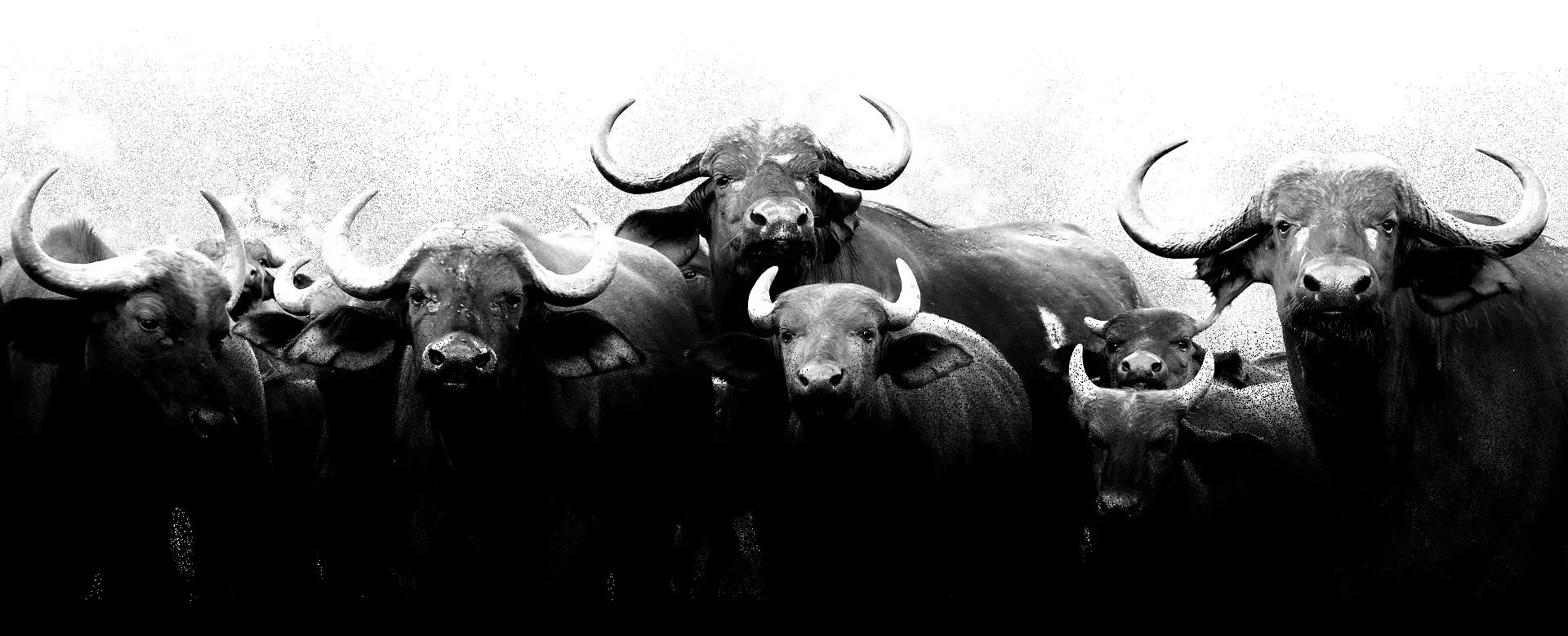
(Mustelidae)
Mustelids
Куницеві
The Mustelidae are a diverse family of carnivoran mammals, including weasels, badgers, otters, polecats, martens, grisons, and wolverines. Otherwise known as mustelids, they form the largest family in the suborder Caniformia of the order Carnivora with about 66 to 70 species in nine subfamilies.
Mustelids inhabit all continents except Australia and Antarctica, and do not occur on Madagascar or oceanic islands. Members of this group can be found in diverse habitats, which include both terrestrial, aquatic and marine environments. Mustelids are mainly carnivorous, with various members of the family exploiting a great diversity of both vertebrate and invertebrate prey. Mustelids are generally proficient hunters; some weasels can take prey larger than themselves. Members of this family often hunt in burrows and crevices, and some species have evolved to become adept at climbing trees (e.g., marten) or swimming (e.g., sea otters, mink) in search of prey.
Generally, mustelids have elongate bodies with short legs and a short rostrum, as typified by weasels, ferrets, mink, and otters. Wolverines and badgers have broader bodies. An order of magnitude difference in size exists between the smallest and largest mustelid species. The smallest species is the least weasel (Mustela nivalis), weighing between 35 and 250 g. Wolverines (Gulo gulo) and sea otters (Enhydra lutris) reach 32 kg and 45 kg, respectively. All mustelids have well developed anal scent glands, which serve various functions, including territorial marking and defense.
Habitat
Mustelidae are distributed from the arctic to the tropics and occupy nearly all terrestrial habitats. Several species are semi- or nearly fully aquatic and inhabit freshwater rivers and streams, as well as coastal marine waters.
Physical Description
Adult mustelids range in size from 114 mm and 25 g (least weasel) to over 1 m and 45 kg (sea otters). These animals are generally long-bodied with short legs. Most species have slender bodies, but some, like badgers and wolverines have much broader bodies. The skull is elongate with a relatively short rostrum. Adult males are generally about 25% larger than females of the same species. The ears are short, as are the legs, each of which bears five digits. The claws do not retract and, in digging species, are especially robust. Mustelids are digitigrade or plantigrade. The dental formula varies among species: 3/3, 1/1, 2-4/2-4, 1/1-2 = 28-38. The canines are long, and the carnassials are well-developed. The upper molars are often narrow in the middle, giving them an hourglass shape. Mustelids have a powerful bite; in many species, the large postglenoid process locks the lower jaw into the upper, causing the lower jaw to only move in the vertical plane, without any rotary motion.
Reproduction
Mating systems vary both within and among species. Many species are polygynous and/or promiscuous. Some species are social, while others are solitary. Social organization can vary within species as well. Mustelids require prolonged periods of copulation to induce ovulation of an unfertilzed egg. As a result, copulation may last for several hours before fertilization can be successful.
Most mustelids breed seasonally, but the length of the reproductive period varies among species. Day length often dictates the onset of the breeding season, which usually lasts 3 to 4 months. Many mustelids undergo delayed implantation, with the fertilized embryo taking up to 10 months (e.g. Meles meles) to implant in the uterus in some species. Environmental conditions such as temperature and day length determine when implantation occurs. Mustelids that live in more seasonal climates are more likely to exhibit delayed implantation. Following implantation, gestation typically lasts 30 to 65 days. Females give birth to a single litter each season, the size of which varies within and among species. For example, sables have an average litter size of 2.2, but can give birth to anywhere from 1 to 7 pups. The mountain weasel averages 8.7 pups per litter, but can have between 3 and 14 young in a single bout of reproduction. Generally, mustelids are altricial, being born small and blind. They reach sexual maturity between 8 months and two years following birth.
Young are generally born in an alricial state, requiring extenisive care and protection from their mother. Young mustelids typically are able to care for themselves when they are about two months old. Females defend territories in order to acquire enough resources to care for their young and most often nurse and protect them in a burrow or den.
Lifespan
Mustelids typically live between 5 and 20 years in the wild.
Behavior
Members of the family Mustelidae are either diurnal or nocturnal. Many of the long, narrow-bodied species are quick and agile, and move in a bounding, scampering fashion. The broader-bodied forms have a more lumbering gait. Some species are adept climbers, while others are excellent swimmers. Many species spend a great deal of time on the ground, searching for food in crevices, burrows, or under cover. Many species shelter in burrows.
Social behavior varies both within and among species, and may vary in relation to local environmental conditions such as food availability. For example, European badgers are known to form groups with several males and females that are all reproductively active within the group. Yet in other parts of their range, European badgers may live solitarily or in pairs. Many species are territorial for at least part of the year, with individuals competing over hunting areas or access to mates (e.g., Mustela erminea).
Communication and Perception
Vision and hearing are important in Mustelidae, but olfaction is particularly well developed. In addition to using scent cues to find food, scent-marking is the main form of communication in this family. Secretions from well-developed scent glands function in territorial interactions, indicate reproductive state, and are used in other social contexts. The degree and function of scent marking varies among species, and according to social and environmental conditions within species.
Food Habits
Mustelids are primarily carnivorous, but some species may at times eat plant material. A wide range of animal taxa are preyed upon by various members of this family; many mustelids are opportunistic feeders rather than specialists. However, many mustelids are especially adept at capturing small, mammalian prey. Weasels, for example, are capable of chasing and capturing rodents in their burrows. Otters are well-adapted to chasing and capturing aquatic prey, including fish, crustaceans, and other aquatic invertebrates. Mustelids hunt in a variety of terrestrial, aquatic, and arboreal habitats. Some species regularly prey on animals larger than themselves. Some species have been known to store food (e.g., Mustela, Gulo).
Predation
Mustelids are generally small carnivores, and are therefore subject to predation by larger carnivores such as canids with which they co-occur. They may also fall prey to large snakes (Serpentes), raptors (Falconiformes), and owls (Strigiformes). Some mustelids secrete noxious chemicals to discourage predators. In some of these species, aposematic color patterns can help ward off predators.
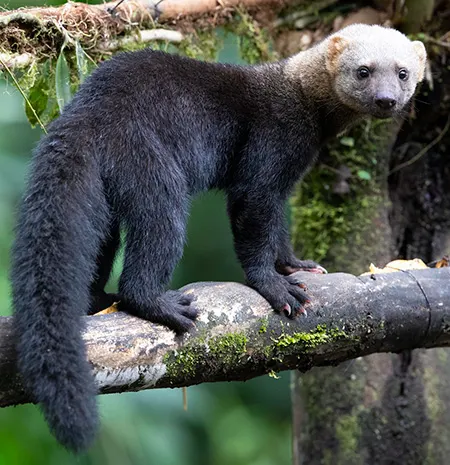
(Eira barbara)
Tayra
Тайра
It is found in Central and South America, with a range extending from southern Mexico to Paraguay and northern Argentina. Its primary habitat is tropical and subtropical rainforests.
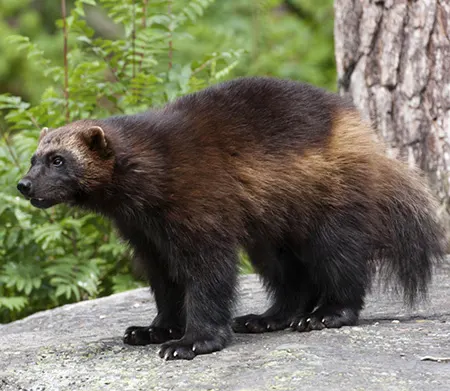
(Gulo gulo)
Wolverine
Росомаха
It is primarily found in isolated Arctic, boreal, and alpine regions of northern Canada, Alaska, Siberia, and Fennoscandia. It is also native to European Russia, the Baltic countries, the Russian Far East, northeastern China, and Mongolia.

(Martes americana)
American Marten
Куниця американська
It is found across much of North America, from Alaska through the forested regions of Canada to the north-eastern United States, extending southward into northern California, the Sierra Nevada, and the Rocky Mountains. It primarily inhabits old, tall coniferous and mixed forests.
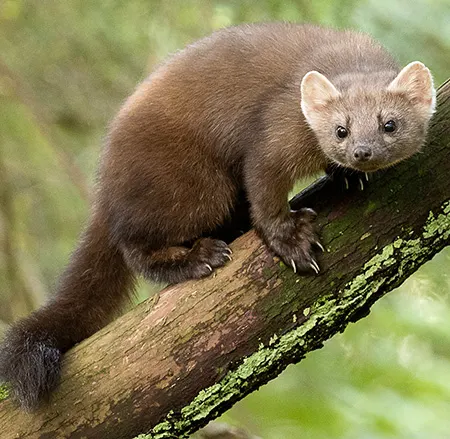
(Martes caurina)
Pacific Marten
Куниця тихоокеанська
Its range extends from the Alexander and Haida Gwaii archipelagos south along the Pacific Northwest coast to Humboldt County, California, and east to the southern Rocky Mountains, reaching as far south as New Mexico.
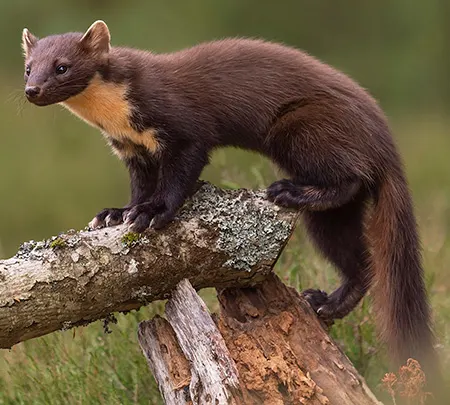
(Martes martes)
European Pine Marten
Куниця лісова
It is widespread across most of Europe, Asia Minor, the Caucasus, and parts of Iran, Iraq, and Syria. It prefers forest habitats, including deciduous, mixed, and coniferous forests.
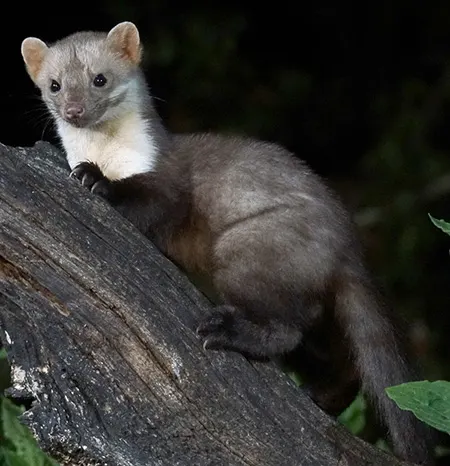
(Martes foina)
Stone Marten
Куниця кам'яна
It ranges from the Iberian Peninsula across Europe and Central Asia to north-western China, and is also found in parts of South Asia, including Afghanistan, Pakistan, India, Nepal, and Bhutan.
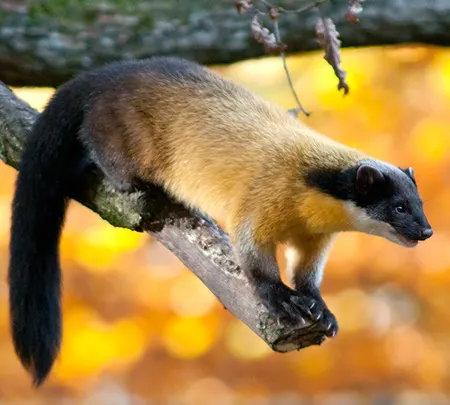
(Martes flavigula)
Yellow-throated Marten
Харза
It is found in Afghanistan and Pakistan, in the Himalayas of India, Nepal and Bhutan, continental southern China and Taiwan, the Korean Peninsula and eastern Russia, extending south to Bangladesh, Myanmar, Thailand, and the Malay Peninsula.
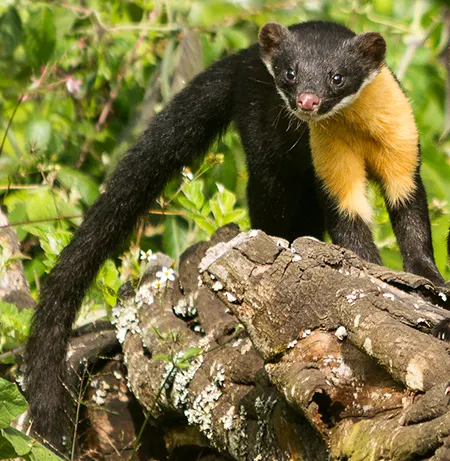
(Martes gwatkinsii)
Nilgiri Marten
Куниця нільгирійська
It inhabits the shola grasslands and South Western Ghats montane rain forests, and occasionally the adjacent moist deciduous forests and commercial plantations, in the South Indian states of Karnataka, Kerala and Tamil Nadu.

(Martes zibellina)
Sable
Соболь
It primarily inhabits forested regions of Russia, from the Ural Mountains across Siberia to northern Mongolia. Its habitat also borders eastern Kazakhstan, China, North Korea and Hokkaido, Japan.
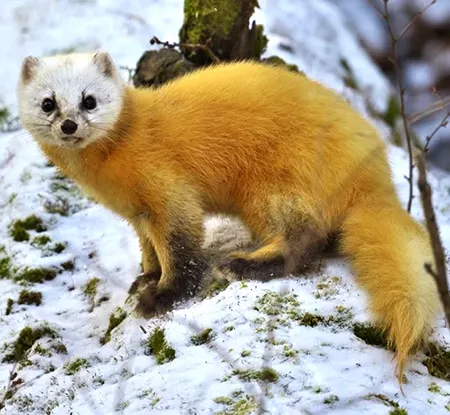
(Martes melampus)
Japanese marten
Куна японська
It is native to the forested regions of Honshu, Kyushu, Shikoku, and Tsushima, Japan.
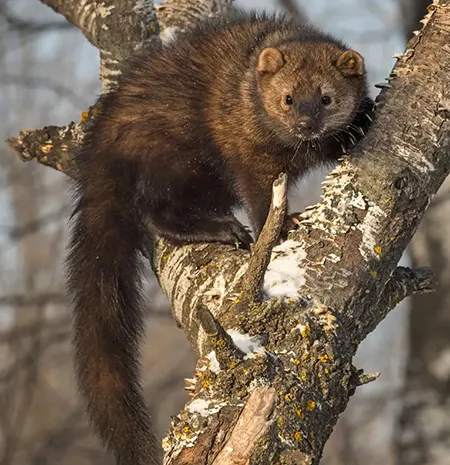
(Pekania pennanti)
Fisher
Ілька
It inhabits the forests of North America, ranging from the Sierra Nevada Mountains in California to the Appalachian Mountains in West Virginia, typically preferring coniferous forests with an abundance of hollow trees.
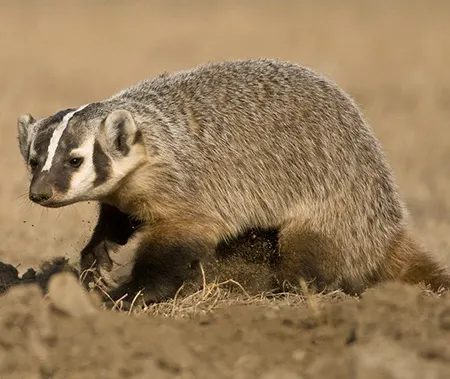
(Taxidea taxus)
American badger
Американський борсук
It is found in the western, central, and north-eastern United States, northern Mexico, and south-central Canada to certain areas of south-western British Columbia. It habitat is typified by open grasslands.
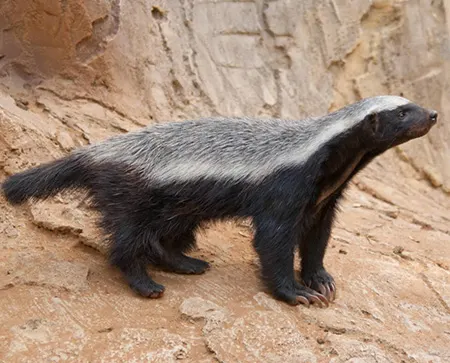
(Mellivora capensis)
Honey badger
Медоїд
It ranges across most of sub-Saharan Africa and outside Africa through Arabia, Iran, and Western Asia to Turkmenistan and the Indian Peninsula. It is predominantly found in deserts, mountainous regions and forests, at elevations of up to 4,000 m.

(Arctonyx albogularis)
Northern Hog Badger
Теледу північний
It ranges from northeast India and Bangladesh northeastward to most of eastern China. An isolated record is also known from eastern Mongolia.
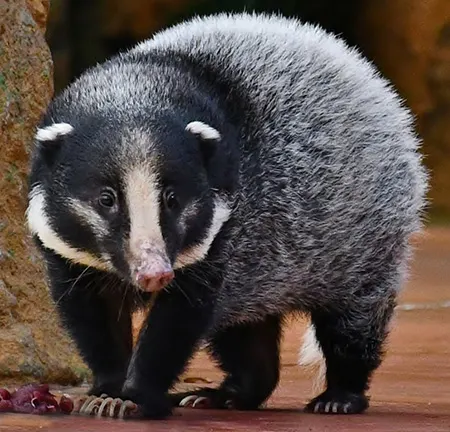
(Arctonyx collaris)
Greater Hog Badger
Теледу великий
It is found in Thailand and much of mainland Southeast Asia, inhabiting tropical evergreen forests and grasslands.
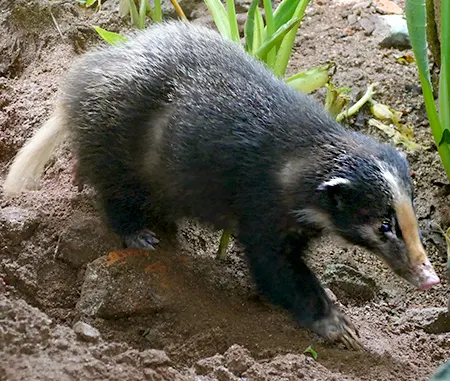
(Arctonyx hoevenii)
Sumatran Hog Badger
Теледу суматранський
It is endemic to the high-altitude regions of Sumatra, particularly the Barisan Range. It typically inhabits montane and cloud forests, as well as tropical subalpine meadows, at elevations of 200–2,600 m.
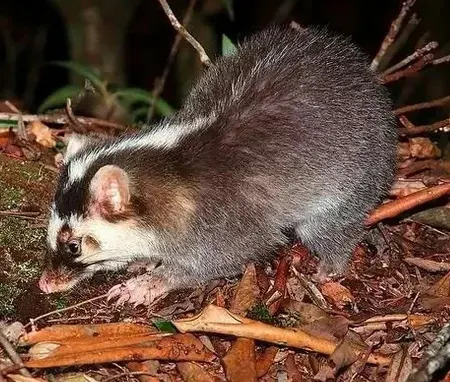
(Melogale everetti)
Bornean Ferret Badger
Харсун борнейський
It is endemic to the island of Borneo. It is predominantly evergreen and montane forests, at elevations of 500–3,000 m.
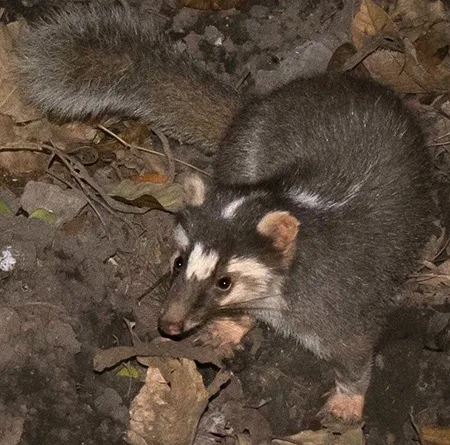
(Melogale moschata)
Chinese Ferret-badger
Харсун китайський
It lives in grassland, open forests, and tropical rainforests from northeast India to southern China, including Hainan Island, and south to Hong Kong and northern Indochina.
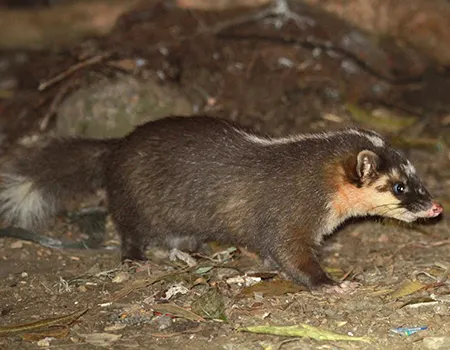
(Melogale orientalis)
Javan Ferret-badger
Харсун яванський
It is endemic to the islands of Java and Bali in Indonesia. It inhabits primary and secondary forests, at elevations of 200–2,600 m.
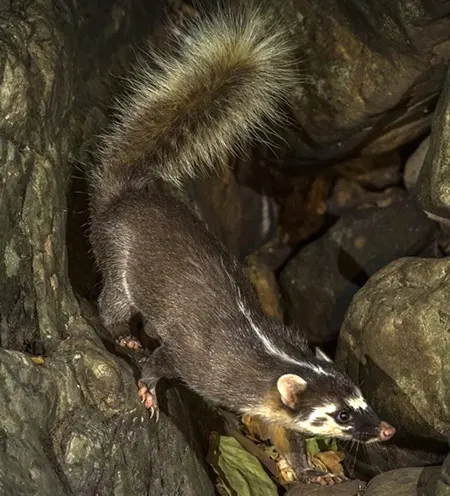
(Melogale personata)
Burmese Ferret-badger
Харсун бірманський
It is native to Southeast Asia, including north-eastern India, Bangladesh, southern Myanmar, Thailand, Nepal, Cambodia, southern China, Laos, and Vietnam.
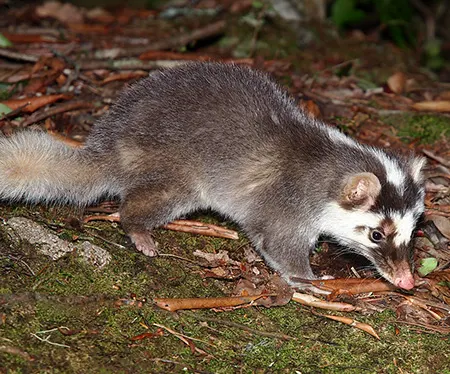
(Melogale subaurantiaca)
Formosan Ferret-badger
Харсун тайванський
It is endemic to the island of Taiwan and inhabits tropical and subtropical forests, grasslands, and cultivated areas.
The genus (Melogale) also includes: Vietnam Ferret-badger (Melogale cucphuongensis).
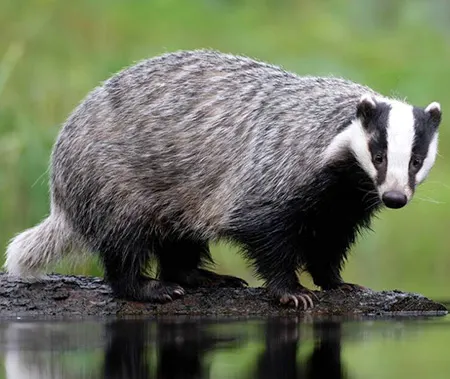
(Meles meles)
European Badger
Борсук європейський
It is found throughout Europe, extending east to the Volga River, as well as in Asia Minor, the Caucasus, northern Iran and Afghanistan, and southern Central Asia. It inhabits deciduous and mixed woodlands, clearings, spinneys, pastureland, and scrub, at elevations of up to 2,000 m.

(Meles anakuma)
Japanese Badger
Борсук японський
It is endemic to Japan and is found on Honshu, Kyushu, Shikoku, and Shōdoshima. It inhabits a variety of woodland and forest habitats.
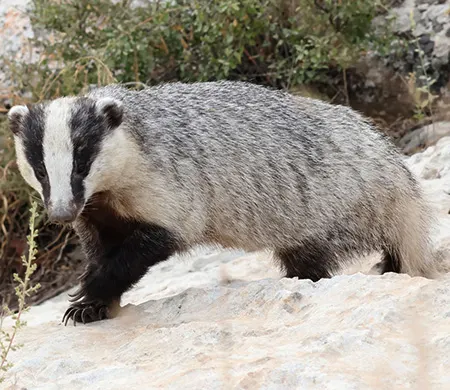
(Meles canescens)
Caucasian Badger
Борсук кавказький
It ranges from Anatolia north to the Caucasus Mountains, south to the Levant and west-central Iran, and east to the Tian Shan mountains. It also occurs on the Mediterranean islands of Crete and Rhodes.
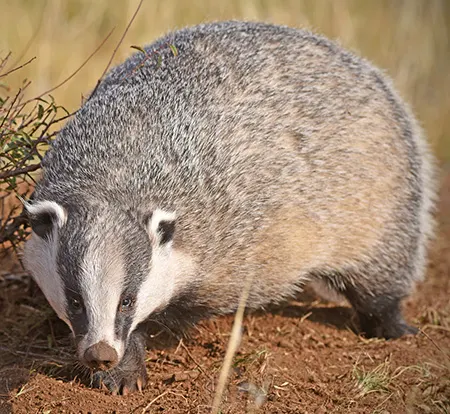
(Meles leucurus)
Asian badger
Борсук азійський
It is native to Mongolia, China, Kazakhstan, Kyrgyzstan, the Korean Peninsula, and Russia (east of the Volga River).
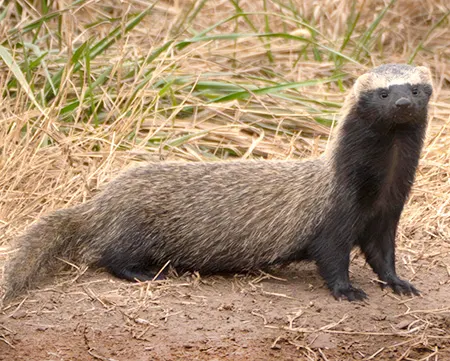
(Galictis cuja)
Lesser Grison
Гризон малий
It is found throughout most of southern South America. It inhabits a wide range of habitats, generally near water, including grasslands, forests, scrub, and mountain meadows, at elevations of up to 4,200 m.
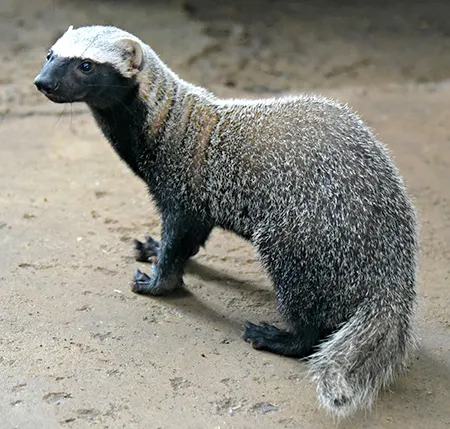
(Galictis vittata)
Greater Grison
Гризон великий
It is native to North and South America, ranging from southern Mexico in the north to central Brazil, Peru, and Bolivia in the south. It inhabits a wide range of forest and cerrado habitats and is usually seen near rivers and streams, at elevations of up to 2,000 m.

(Lyncodon patagonicus)
Patagonian Weasel
Ласка патагонська
Its geographic range includes the Pampas of western Argentina and southern Chile.
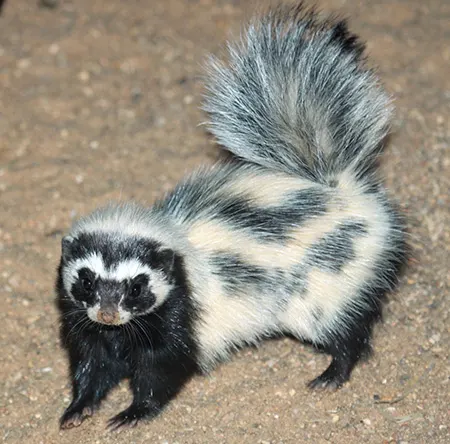
(Ictonyx libycus)
Saharan Striped Polecat
Зорила сахарська
It is found in northern Africa, along the northern and southern edges of the Sahara Desert. Arid, rocky terrain and sandy semi-deserts are its preferred habitats, although it is rarely found in woodlands.
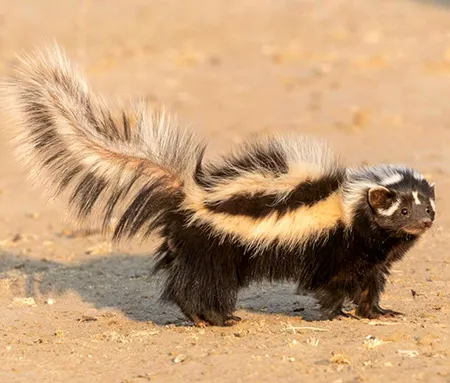
(Ictonyx striatus)
Striped Polecat
Зорила звичайна
It inhabits most of Sub-Saharan Africa, ranging from Mauritania across to south-eastern Egypt in the north, and stretching down south to South Africa. It inhabits grasslands, forests, rocky areas, and deserts.
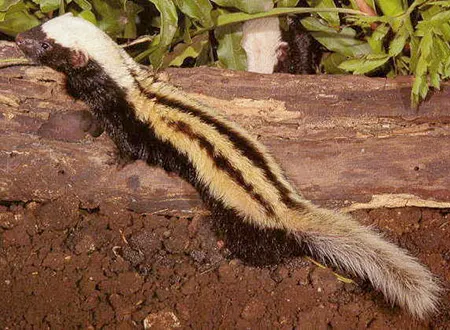
(Poecilogale albinucha)
African Striped Weasel
Ласка смугаста
It is found across much of Africa south of the equator, ranging from the Democratic Republic of the Congo and Kenya in the north to southern South Africa. It inhabits semideserts, rainforests, fynbos, and pine plantations.
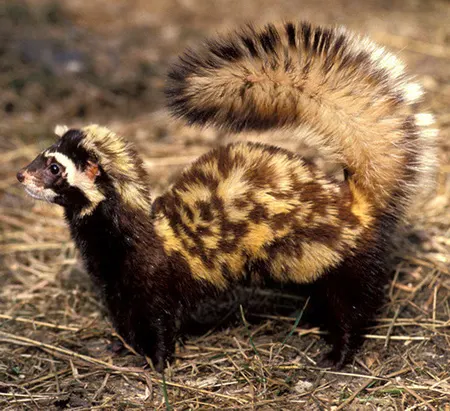
(Vormela peregusna)
Marbled Polecat
Перегузня звичайна
It is distributed from Southeast Europe to the Caucasus, the Levant and Central Asia into north-western Pakistan, southern Mongolia and northern China. It inhabits open desert, semidesert, and semiarid rocky areas in upland valleys and low hill ranges, steppe country, and arid subtropical scrub forest.

(Mustela eversmanii)
Steppe Polecat
Тхір степовий
It is found from Central and Eastern Europe, extending eastward across the forest-steppe, steppe, and semi-deserts of southern Russia, northern Georgia, Kazakhstan, Turkmenistan, Uzbekistan, Tajikistan, and Kyrgyzstan to Mongolia and northern and western China.
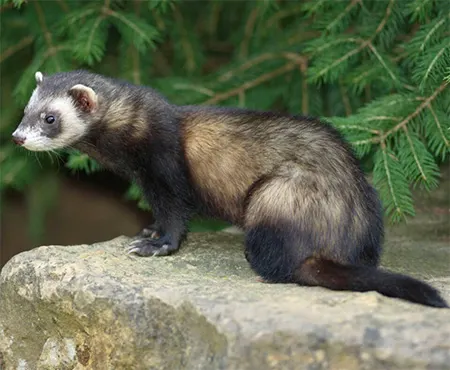
(Mustela putorius)
European Polecat
Тхір лісовий
It is native to most of Europe west of the Ural Mountains (except Ireland, northern Scandinavia, and parts of the Balkans), and also occurs in northern Morocco. It inhabits along bodies of fresh water, in wetlands, at the edges of forests, and in grasslands with patches of scrub trees.
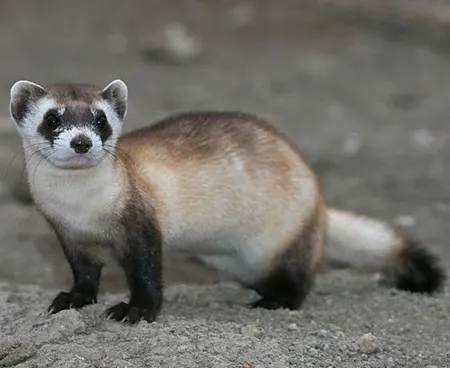
(Mustela nigripes)
Black-footed Ferret
Тхір чорноногий
It is found in central North America, ranging from southern Alberta and southern Saskatchewan south to Texas, New Mexico, and Arizona. It inhabits shortgrass and mixed-grass prairies, desert grasslands, shrub and sagebrush steppes, mountain grasslands, and semi-arid grasslands.

(Mustela altaica)
Mountain Weasel
Солонгой
It is found in parts of Asia, ranging from Kazakhstan, Tibet, and the Himalayas to Mongolia, north-eastern China, and southern Siberia, extending south to Ladakh, India. It primarily lives in high-altitude environments, as well as rocky tundra and grassy woodlands, at elevations of 1,500–4,000 m.
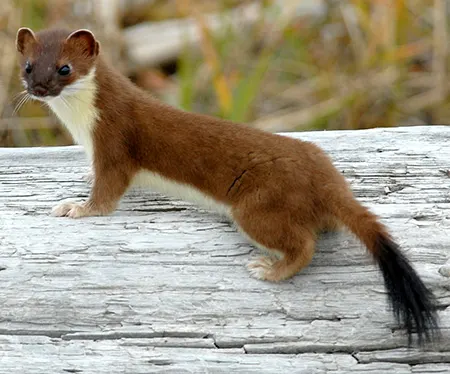
(Mustela erminea)
Stoat
Горностай
It is native to much of Eurasia and the northern regions of North America. It inhabits river valleys; the banks of streams, lakes, ponds, and swamps; floodplains; forests and forest edges; copses and shrub thickets; and is occasionally found in fields.

(Mustela haidarum)
Haida Ermine
Горностай гайдинський
It is found on a few islands off the coast of British Columbia, including Graham and Moresby islands in the Haida Gwaii archipelago, and in south-eastern Alaska, on Prince of Wales Island and possibly Suemez Island. It inhabits temperate rainforest habitats.
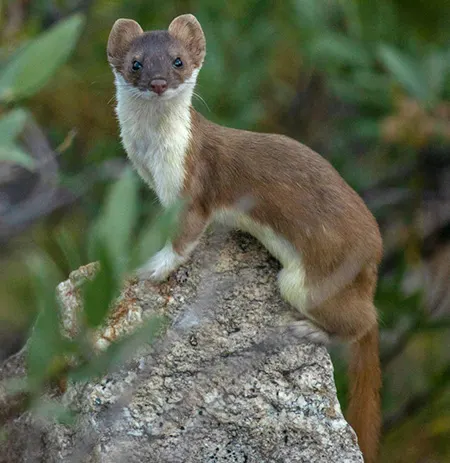
(Mustela richardsonii)
American Ermine
Горностай американський
It is found throughout most of North America, except for most of Alaska, eastern Yukon, much of Arctic Canada and Greenland, as well as most of the Southeastern United States and the Great Plains.
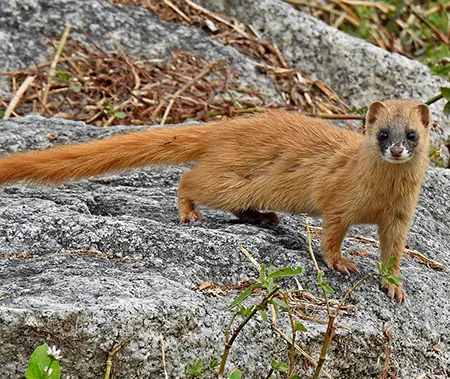
(Mustela itatsi)
Japanese Weasel
Ласка японська
It is native to Japan where it occurs on the islands of Honshū, Kyūshū and Shikoku. It inhabits grasslands, shrublands, forests and plantations.
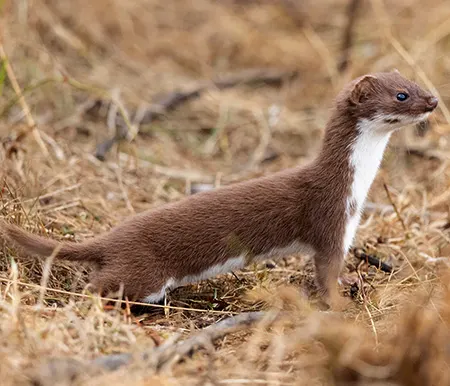
(Mustela nivalis)
Least Weasel
Ласка мала
It has a circumboreal, Holarctic distribution, encompassing much of Europe, North Africa, Asia, and parts of northern North America. It has also been introduced to New Zealand, Malta, Crete, the Azores, and São Tomé.

(Mustela kathiah)
Yellow-bellied Weasel
Ласка жовтошия
It occurs in Bhutan, Myanmar, China, India, Laos, Nepal, Pakistan, Thailand, and Vietnam. It inhabits forested areas at elevations of 1,000–2,000 m.
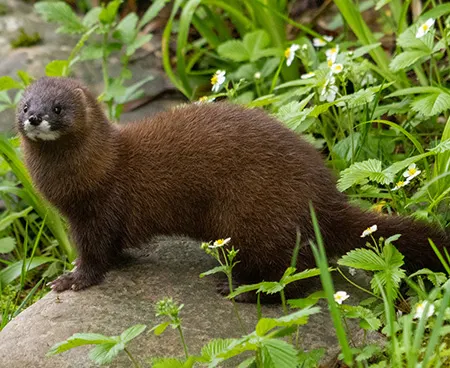
(Mustela lutreola)
European Mink
Норка європейська
The current range includes an isolated population in northern Spain and western France, which is widely separated from the main range in Eastern Europe.

(Mustela lutreolina)
Indonesian Mountain Weasel
Норка яванська
It lives on the islands of Java and Sumatra in Indonesia, inhabiting tropical rainforests at montane elevations above 1,000 m.
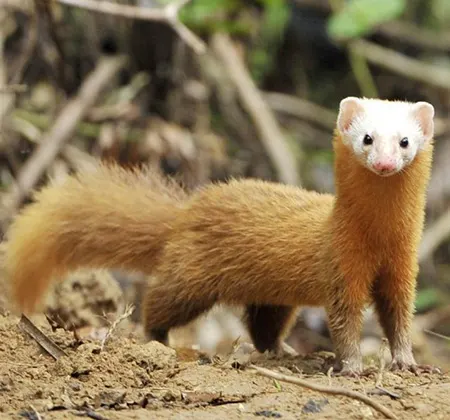
(Mustela nudipes)
Malayan Weasel
Норка малайська
It is native to the Malay Peninsula, from southern Thailand to Peninsular Malaysia, as well as Sumatra and Borneo. It inhabits lowland forests, but has also been recorded in a variety of habitats, ranging from swamps and montane forests to plantations and high-elevation montane scrub up to 1,700 m.
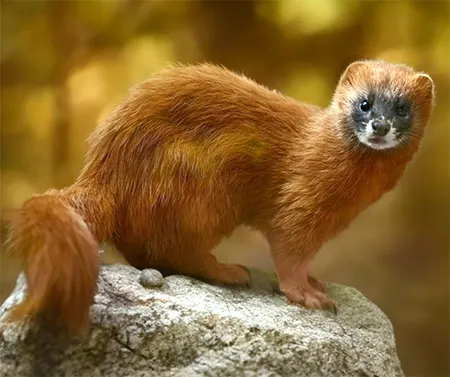
(Mustela sibirica)
Siberian Weasel
Колонок
It ranges from the Himalayas in Pakistan, India, Nepal, and Bhutan to northern Myanmar, northern Thailand, Laos, Taiwan, China, Korea, and Japan. In Russia, it occurs from the western Urals across Siberia to the Russian Far East.
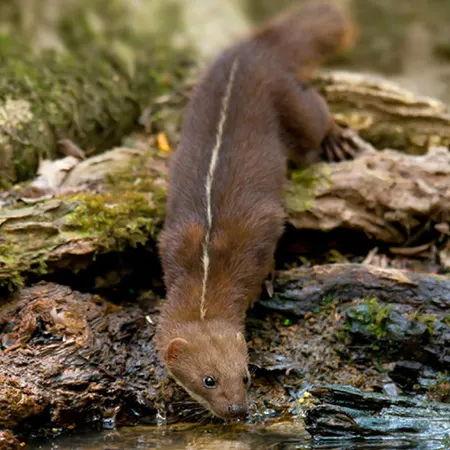
(Mustela strigidorsa)
Back-striped Weasel
Норка білосмуга
It is found in north-eastern India, northern and central Myanmar, southern China, northern Thailand, and northern and central Laos and Vietnam. It lives mainly in evergreen forests on hills and mountains, at elevations of up to 2,500 m.
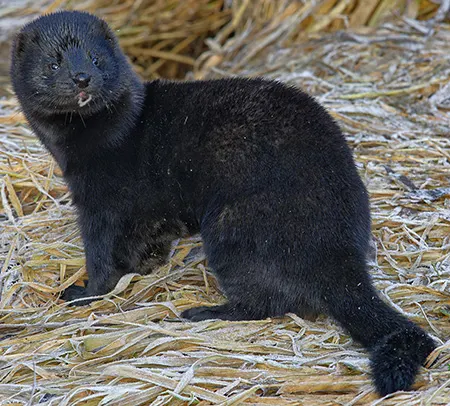
(Neogale vison)
American Mink
Норка американська
It lives in North America, from Alaska and Canada across nearly the entire United States. It was also introduced to Europe, where it has become widely established. It is found along rivers, lakes, and swamps, and prefers areas with dense vegetation.
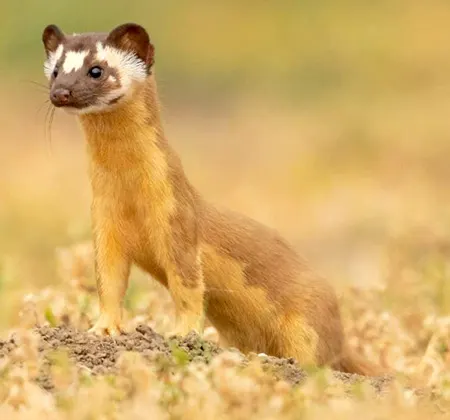
(Neogale frenata)
Long-tailed Weasel
Ласка довгохвоста
It is distributed from the Canadian–American border, through Central America, to the northern regions of South America. It inhabits bushy areas and sparse forests, field edges, coastal meadows, marshy areas, and swamps.

(Neogale africana)
Amazon Weasel
Ласка амазонська
It is found in the Amazon Basin, in north-central Brazil, northern Bolivia, and eastern Peru and Ecuador.
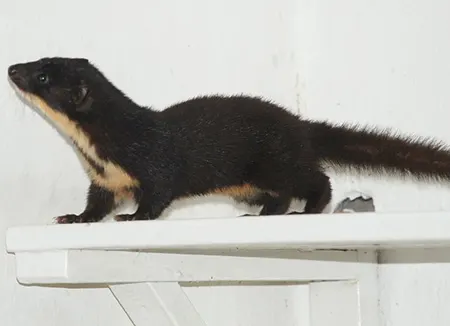
(Neogale felipei)
Colombian Weasel
Ласка колумбійська
It is known with certainty only from the departments of Huila and Cauca in Colombia, and from nearby northern Ecuador.
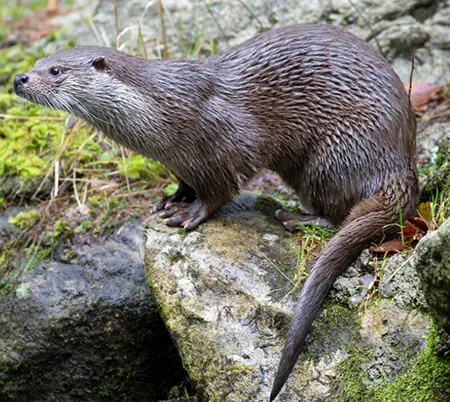
(Lutra lutra)
Eurasian Otter
Видра євразійська
It is widely distributed across parts of Asia and northern Africa, and extends through Europe, reaching as far south as Palestine. Inhabits rivers, lakes, and ponds.
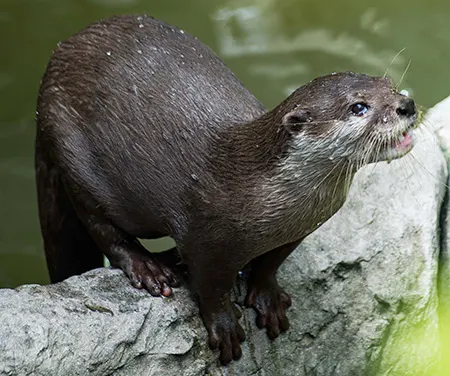
(Lutra sumatrana)
Hairy-nosed Otter
Видра суматранська
It occurs in Southeast Asia from southern Thailand, Cambodia, southern Vietnam and Peninsular Malaysia to Sumatra and Borneo. It inhabits swamp forests, wetlands, mangrove forests, and mountain streams.
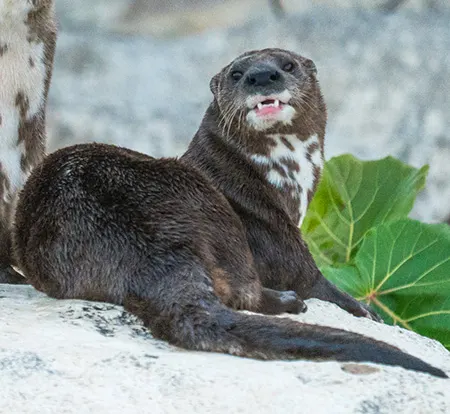
(Hydrictis maculicollis)
Spotted-necked Otter
Видра плямистошия
It inhabits lakes and larger rivers throughout much of Africa south of 10°N. It is common in Lake Victoria and across Zambia, but is absent from the Zambezi River below Victoria Falls.
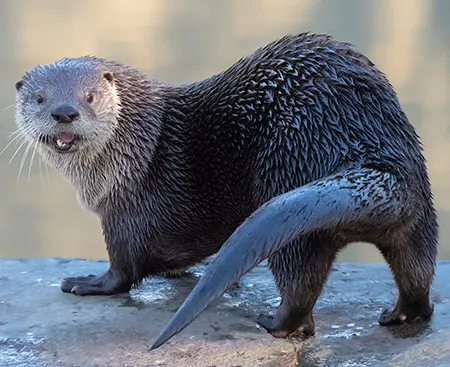
(Lontra canadensis)
North American River Otter
Видра канадська
It is found throughout North America, inhabiting inland waterways and coastal areas in Canada, the Pacific Northwest, the Atlantic states, and the Gulf of Mexico.
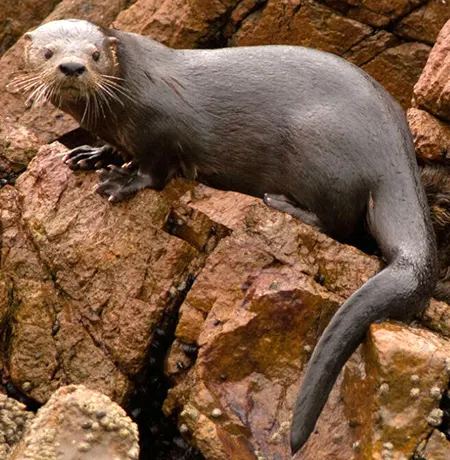
(Lontra felina)
Marine Otter
Видра морська
It is found in littoral areas of southwestern South America, close to shore and in the intertidal areas of northern Peru, along the entire coast of Chile, and the extreme southern reaches of Argentina. Occasionally seen as far as the Falkland Islands.
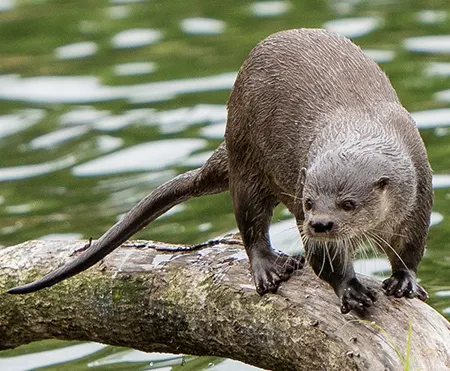
(Lontra longicaudis)
Neotropical Otter
Видра довгохвоста
It is found in freshwater systems from Mexico and Central America through mainland South America, as well as the island of Trinidad. It prefers clear, fast-flowing rivers, at elevations of up to 3,000 m.
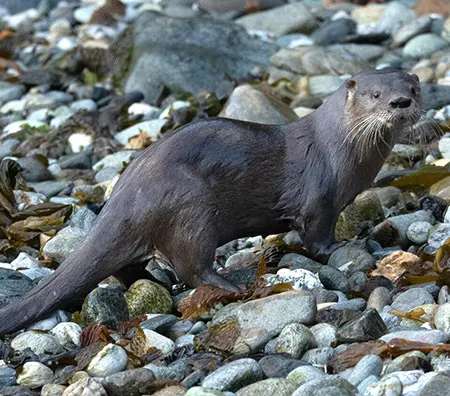
(Lontra provocax)
Southern River Otter
Видра південна
It is found in southern Chile, and in southern Argentina, from Neuquén to Tierra del Fuego. It inhabits marine, freshwater, and terrestrial habitats, but is mostly found in freshwater lakes and rivers.
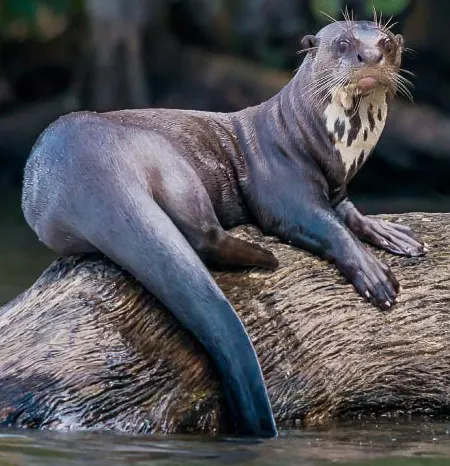
(Pteronura brasiliensis)
Giant Otter
Видра гігантська
It is endemic to South America and is found throughout the Orinoco, Amazon, and La Plata river systems, which extend from east of the Andes in northern Argentina northward to Venezuela and Colombia.

(Aonyx capensis)
African Clawless Otter
Видра капська
It inhabits permanent water bodies in savanna and lowland forest regions throughout much of sub-Saharan Africa. It can be found anywhere from open coastal plains, to semiarid regions, to densely forested areas.

(Aonyx congicus)
Congo Clawless Otter
Видра конголезька
It is found in the lower Congo Basin, which extends from south-eastern Nigeria to western Uganda. It inhabits small swamps, ponds, and streams of heavy rainforests.
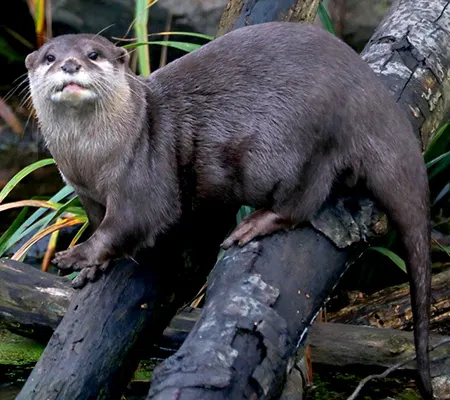
(Aonyx cinereus)
Asian Small-clawed Otter
Видра попеляста
It is found in parts of India and Southeast Asia, including the islands of Sumatra, Java, Borneo, and Palawan. It lives in freshwater wetlands such as swamps, meandering rivers, irrigated rice fields as well as estuaries, coastal lagoons and tidal pools.
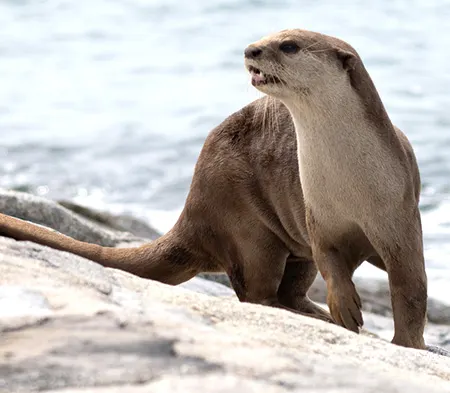
(Lutrogale perspicillata)
Smooth-coated Otter
Видра гладкошерста
It is found throughout much of southern Asia, from India eastward to Peninsular Malaysia, and the islands of Borneo, Sumatra, and Java. It inhabits lowlands, coastal mangrove forests, peat swamp forests, freshwater wetlands, large forested rivers, lakes, and rice paddies.

(Enhydra lutris)
Sea Otter
Калан
It is distributed along the northern shores of the Pacific Ocean, including Russia (Kamchatka, the Commander and Kuril Islands), the Aleutian Islands, southern Alaska, western Canada, and the western USA. It inhabits temperate coastal waters with rocky or soft sediment ocean bottom.
